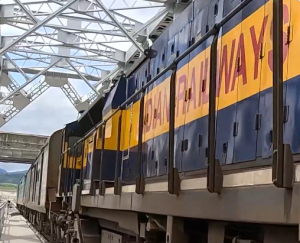Indian Railways has achieved a milestone by linking the remote border state of Mizoram in the country’s Northeast with the national grid. The project entailed laying tracks over inhospitable hilly terrain and overcoming several hurdles for over a decade before it was finally completed.
On September 13, Prime Minister Narendra Modi inaugurated the 51.38-kilometer-long Bairabi-Sairang railway project in Mizoram, more than 172 years after the railways were introduced in India during colonial rule.
Mizoram will be the fourth state of the eight states in the Northeast to have its capital linked to the national railway grid.
Union Minister for Railways Ashwini Vaishnaw termed the project “very challenging” and its completion as “historic” for Mizoram.
Bairabi, near the state’s border with Assam, was linked to the rail network as a meter-gauge station in the late 1980s. In 2016, it was upgraded to broad gauge under the 83.55 km Kathakal-Bairabi Gauge Conversion Project. The preliminary survey for the Bairabi-Sairang line was sanctioned in 1999, but progress on the project was slow owing to the hilly terrain through which the proposed alignment passed. Subsequently, the railway conducted a reconnaissance engineering-cum-traffic survey, which was completed in 2006. The project was finally sanctioned in 2008 and implementation began six years later.
The Sairang-Bairabi railway project is considered an engineering marvel, next only to the Chenab rail section in the Kashmir valley and the Pamban bridge in Tamil Nadu. Built at a cost of over 80,000 million rupees (approximately $910 million), the track snakes through as many as 48 tunnels over 12.85 kilometers (8 miles) in total, with 55 major bridges. The longest tunnel (No. 40) is 1.37 km (0.85 miles) and the track also has one of the tallest pier bridges over the Kurung river near Sairang at 114 m above the ground. Beyond the railway itself, nearly 200 km of approach roads were constructed to ferry materials for the project. Electrification of the entire Bairabi-Sairang line is in progress and likely to be completed by the end of this year.
Kapinjal Kishore Sharma, chief public relations officer of North East Frontier Railways, told the media that the project faced “tremendous challenges,” from continuous rainfall to the difficulty of transporting construction materials through remote areas. Despite the challenges, the project was expedited with an “eco-sensitive approach” by constructing more tunnels and elevated viaducts to lessen deforestation and destruction of habitats. Twenty-six workers were killed when a bridge collapsed two years ago.
The Bairabi-Sairang railway line is expected to have a profound impact on Mizoram’s economy by lowering transport costs as well as generating jobs and tourism that would boost demand in hotels, homestays, handicraft markets, and transport services. The cost of commodities is estimated to fall by at least 20 percent, making life in the state more affordable to the more than 1,200,000 people of Mizoram.
Mizoram grows a range of horticulture products, including orange, guava, pineapple, ginger and turmeric, but faces hurdles in selling the products outside the state owing to transportation hurdles. Currently, the post-harvest losses due to lack of adequate transport facilities in the northeastern region are estimated at around 25 to 30 percent.
The new railway track will be a relief for cancer patients as the state does not have facilities for specialized treatments. Incidentally, Mizoram has the highest cancer incidence rate in the country. For many patients, treatment requires travelling to far-off destinations such as Guwahati or other parts of the country over long distances by road or by flight at exorbitant rates.
Connecting Mizoram with rail is part of a larger project to link all state capitals in the northeastern region of the country. Nagaland, Manipur, Meghalaya, and Sikkim are the other states in the region whose capitals are yet to be connected with the railway network. Since 2014, allocations for railway projects in Northeast have multiplied five times. The government has accelerated efforts to integrate all state capitals in the region into the national railway grid by 2029.
Eventually, the plan is to extend the railway network to the neighboring countries of Bhutan, Bangladesh, and Myanmar. The success of this plan will also depend on the domestic situation in each of these countries. From Agartala, the railway route via Akhaura extends to Bangladesh, forming part of the plan to link Kolkata and Agartala through Dhaka, as it will be a shorter route than passing through West Bengal and Assam. The ongoing 223 km Sairang–Hbicchhuah project in Mizoram will extend to the state’s southern border, opening a direct trade route to Myanmar and Southeast Asia. Work on a 69-kilometer track connecting Assam and Gelephu in Bhutan is expected to begin soon, which will offer the country its first railway connectivity.





























